If you want to learn flower arrangement from scratch, here is a guide for you
Plants and Flowers Lifestyle
Click on the blue words below the title to follow the tips for growing flowers

If you can find something artistic and can cultivate your sentiments when you are at home, flower arrangement is the best choice. For flower arrangement, we can make it look good even if we just play around with it, but if we want to have a more aesthetic feeling, we need to study it further.
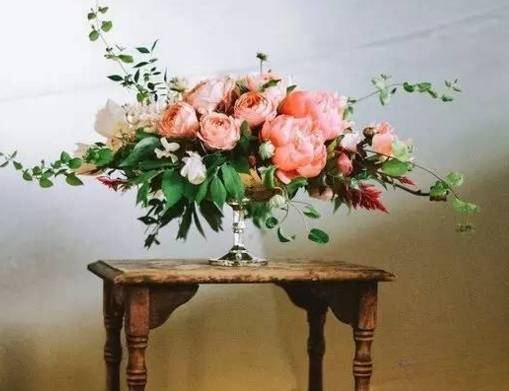
Commonly used flower arrangement materials
◆ ◆ ◆
The flowers used for flower arrangement are called fresh cut flowers.
Cut flowers for every season: roses, lilies, carnations and chrysanthemums.
Spring cut flowers: There are many woody cut flowers, such as peach blossoms, cherry blossoms, pear blossoms, crabapples, peonies, peonies, and tulips.
Summer cut flowers: lotus, water lily, hydrangea, sunflower, cut leaves (grass, spider plant, bird's nest fern, mountain goat teeth);
Fall cut flowers : more varieties of chrysanthemums, dahlias, marigolds, cockscombs, various South African imported flowers;
Cut flowers in winter: camellia, plum blossom, magnolia, amaryllis, and Australian wintersweet.
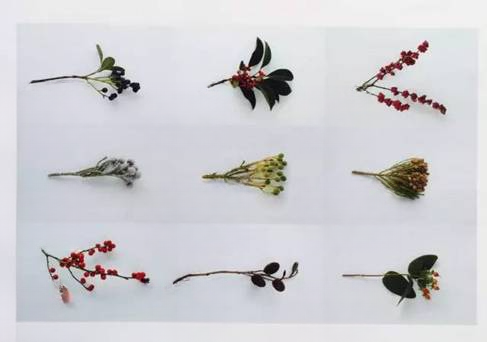
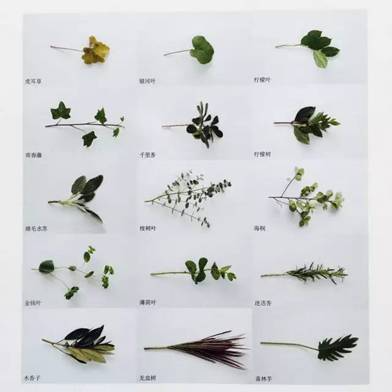
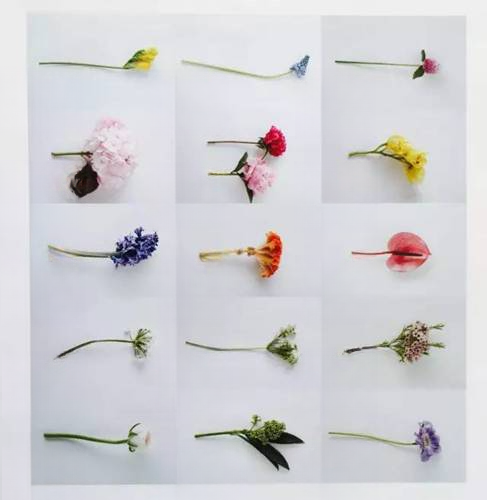
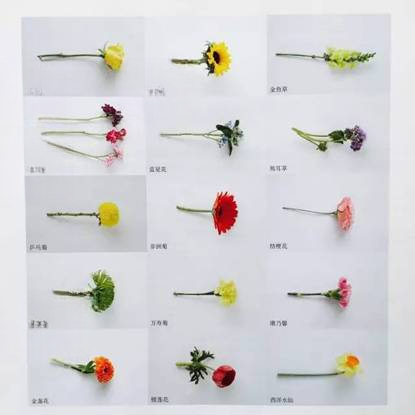
Choose fresh and healthy flowers
◆◆◆
Try to choose flowers that are in bud state, or have tight, inward-retracted flower heads. You can gently shake the flowers, especially small flowers such as lace flowers and baby's breath, to see if the flower heads and petals will fall off. If they do, it means that the flowers are not very fresh or healthy.
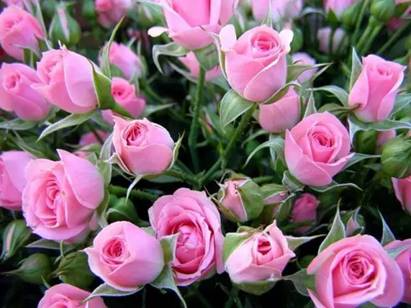
First, look at the length of the flower stalk. In order to keep the flowers fresh, flower shops cut off a section of the lower end of the branches and stems every day, so that they can absorb water or nutrient solution. So relatively speaking, the longer the flower stalk, the fresher it is. Most flowers are considered fresh if the flower stalk is about 20-30cm; the rose's flower stalk should be 40-50cm.
Second, check whether the pedicel is broken or has been soaked for too long. If the pedicel is soaked for too long, it will become soft or even black. In this case, even if the flower head is good, it is not recommended to buy it. In addition, for hollow pedicels such as ranunculus and anemone, you must also pay attention to whether the pedicel is flattened or broken.
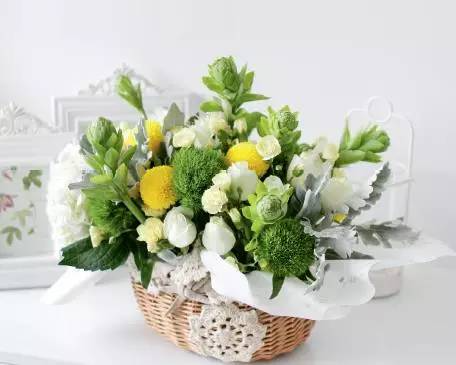
Choose leaves that are upright and stretched, without damage or disease spots. For small leaves like the green fan, you can also gently shake it like the baby's breath to see if the leaves fall off easily.
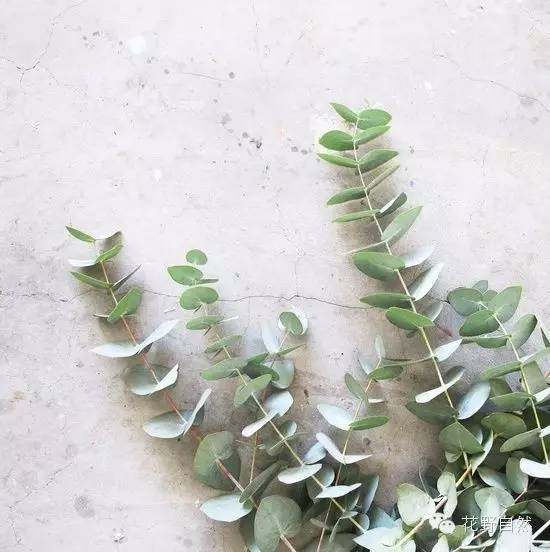
Flower preparation before arranging
◆◆◆
Broken petals and broken flower heads should be removed. Some flowers have multiple flower heads on one stem. You can keep only the largest or best one and remove the others. This will not only keep more nutrients for the good flower heads, but also make them more beautiful.
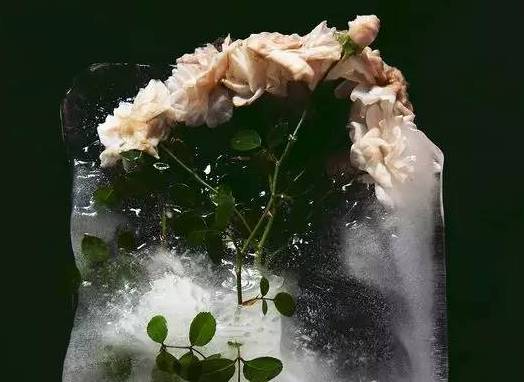
Comparing the height of the vase and the amount of water it holds (the amount of water is generally controlled at about 1/3-1/2 of the vase), and using "no leaves in the water" (if using floral mud, ensure that "no leaves in the mud") as the standard, cut off the leaves from the roots. For roses with thorns on their stems, it is best to remove the thorns without scratching the epidermis.
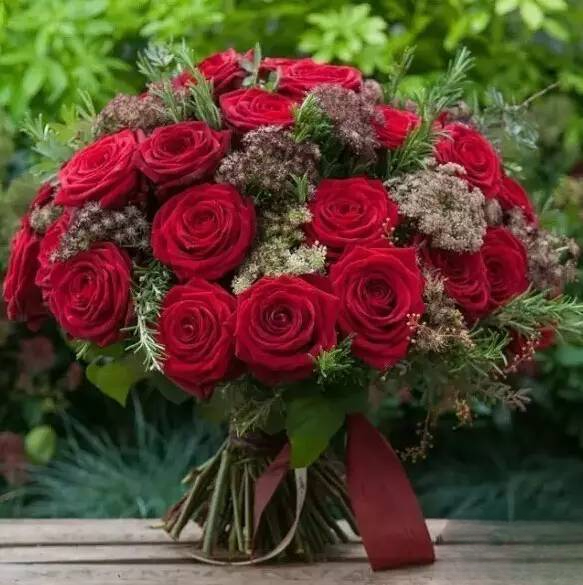
The end of the pedicel of different flowers is handled slightly differently: ordinary pedicels are cut obliquely with flower shears, hollow pedicels are cut flat with flower knives or sharp fruit knives, and branches are cut into crosses with branch shears. This is done to enhance the water absorption capacity of flowers, branches, etc. and to extend the viewing period as much as possible.

Make the flowers last as long as possible
◆◆◆
The first priority is to pick fresh and healthy flowers. The second priority is to change the water frequently, once a day or every two days.
Every time you change the water, you should clean the vase and pedicels, and remove the petals that are about to fall off. You can use a long-handled vase brush to clean it, or try a test tube brush or bottle brush. Be sure to clean the bottom of the vase and the water level.
You can add a little baking soda or sugar to the water to supplement the nutrients of the flowers, so that they can live more moisturized and bloom longer.
Choice of flower pot
◆◆◆
Glass vases are the most suitable for beginners. They come in a variety of styles and colors and are versatile. They are also easier to observe changes in water quality and are easy to clean.
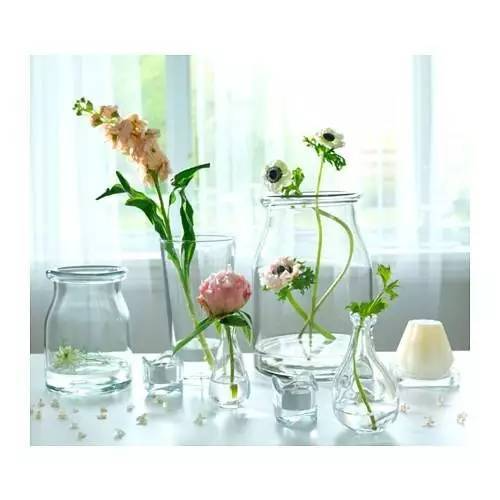
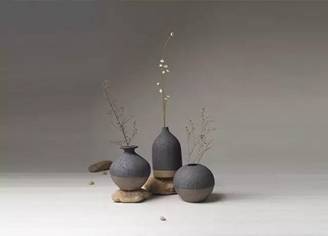
Ceramics are also very common flower vases and are easy to buy. In addition to exquisite white ceramics, there are also Portuguese black pottery and coarse pottery to choose from, which have a rustic feel.
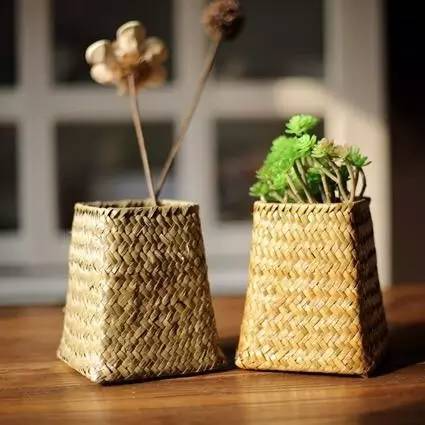
These two types of vases are more suitable for arranging dried flowers, but you can also nest glass or ceramic vases of appropriate sizes inside them and use them to hold water.
It is not recommended to use floral mud with wooden and straw vases, because dry wood chips and rattan are not suitable for long-term immersion in water.
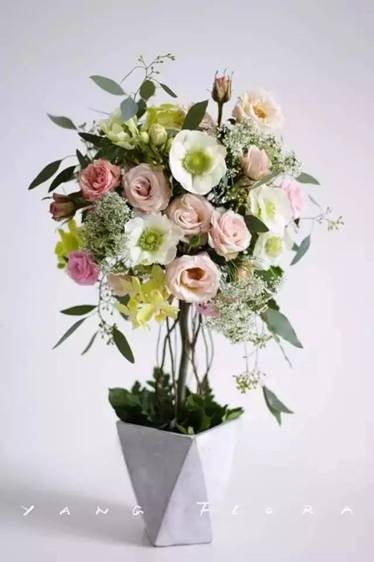
Cement flower vases with an industrial feel are particularly suitable for the Nordic style. The gray tone and texture of the cement allow it to hold a variety of color combinations and is very inclusive in style.
In addition to the very common metal frames used to place air plants, there are now some electroplated metal vases, such as gold-plated, silver-plated, brass-plated, etc., which are relatively tough in style.
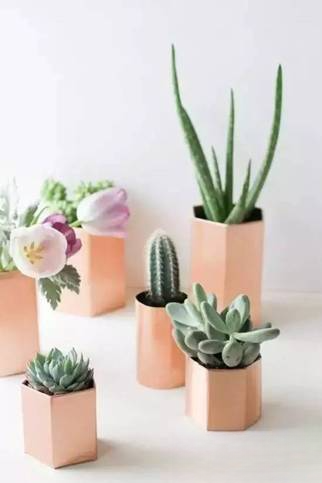
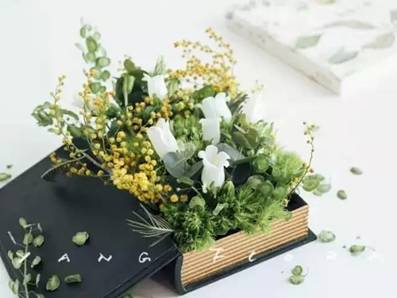
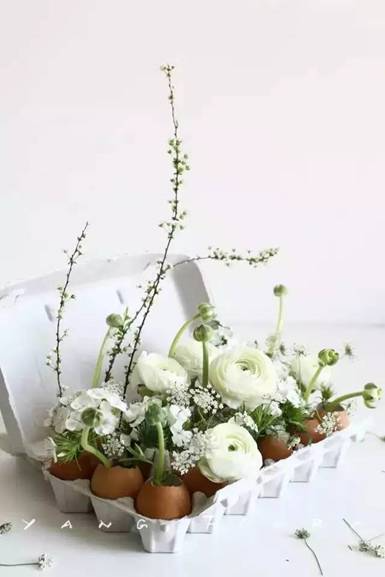
In addition to conventional vases, in fact, many things can be used as vases, such as: books, bird cages, wooden stakes, egg shells, shoes, pots and pans, and hats.
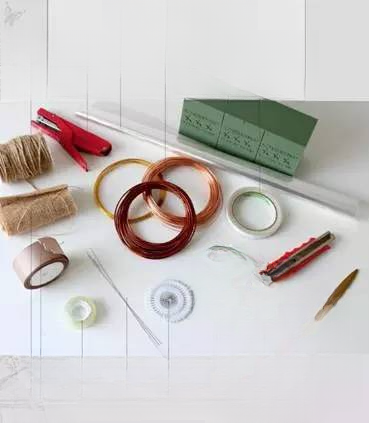
tool
◆◆◆
Professional florists usually use floral knives, but beginners can just use floral scissors. The heads are either round or pointed, but both have thicker handles and sharper blades, which make it easier to cut the flower stems and ensure water absorption.
Cut branches of peach blossoms, cherry blossoms, etc.
How to plug in?
◆◆◆
Use your imagination to realize your ideas with flowers. It is not enough to simply copy other people's good works, because each flower has its own style and expression. So the most important thing is to understand what makes you think the works of others are good and how to express them. If you understand these, you can create wonderful works even if you use different flowers.
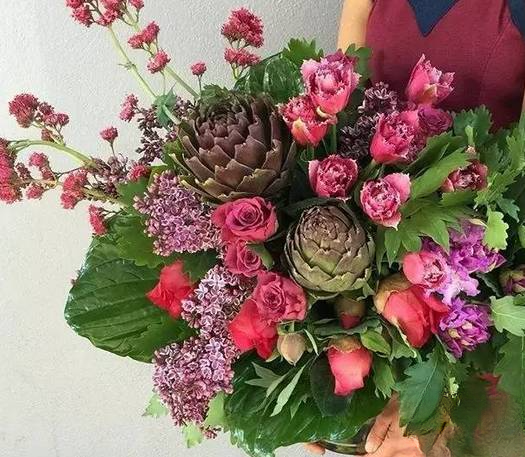
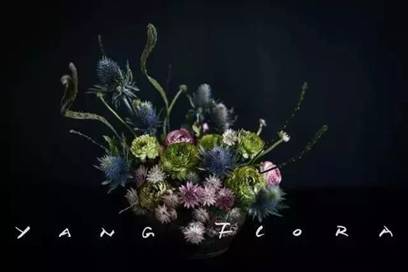
Here are some suggestions for beginners on color:
1. You can choose isolated colors and flowers with the same hue. There are unlimited types and you can put them together without making mistakes.
2. Choose flowers of the same color family, for example, from yellow to orange to red, two or three hues, but all are warm tones, the style is unified, or blue to purple to green, all are cool tones, also a unified style.
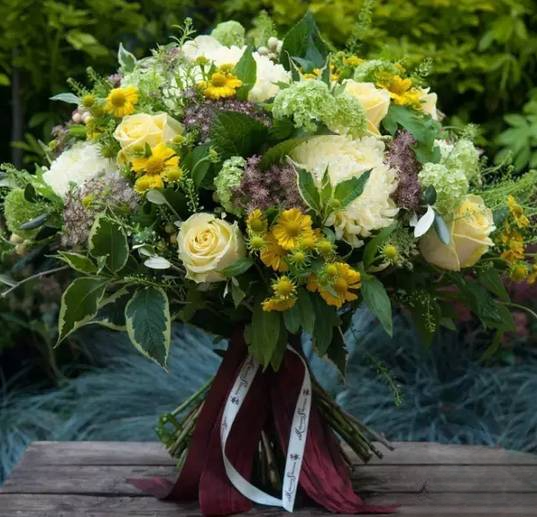
3. Contrasting colors can be selected according to the color wheel. Common contrasting colors are: yellow and purple, orange and blue, red and green, and the very popular macaron color. Although the saturation is relatively low, contrasting colors can also be played.
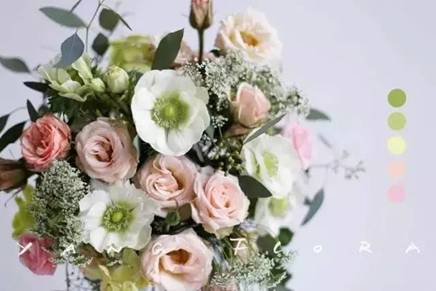
One is the posture of the flower itself. For example, if you choose a sunflower, its flower head is very large. If you choose some very small flowers, they can only be used as supporting flowers.
If you want to make a comparison with sunflowers, you can choose some fruits, because they are all larger, so they will match each other. Otherwise, you can only use sunflowers as the main flowers and the others as supporting flowers.
There are also flowers such as snow willow and June snow. In terms of overall shape, these are linear flowers, which are very elegant. At this time, you cannot choose flowers such as sunflowers to match them. You can find some delicate and soft flowers to match them.
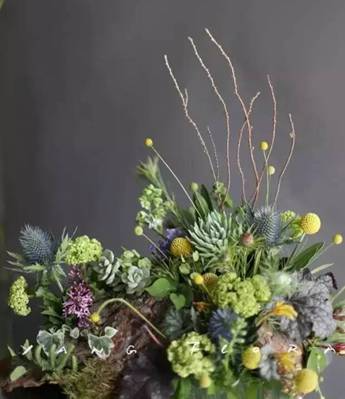
The second aspect of shape refers to the overall shape of your work. If you want the overall shape to be spherical, then you should avoid choosing flowers with a sense of lines, but there are still many choices, such as roses, ping-pong chrysanthemums and various small chrysanthemums, and slowly spiral them into a ball.
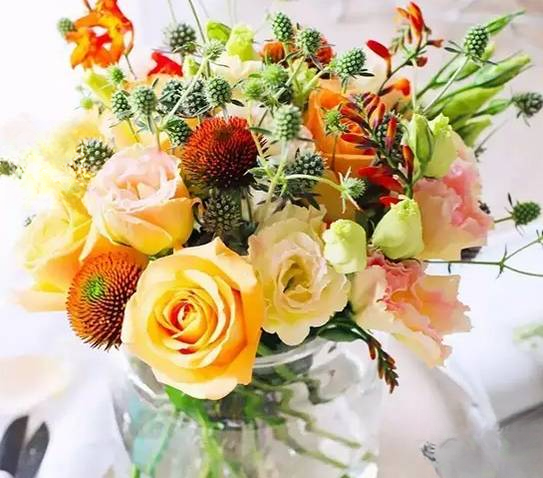
The textures of the flowers you choose should either blend or contrast.
For example, in winter, Christmas wreaths are made of pine, cypress and pine cones. These two flowers are contrasting in texture, one is a wood-colored fruit shape, and the other is a green needle-shaped leaf, but they go very well together. Although they are contrasting in texture, in nature, their plant properties are very similar, and they may even come from the same tree.
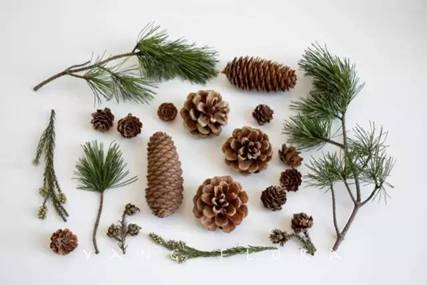
Seasonal flower arrangement cases
◆◆◆
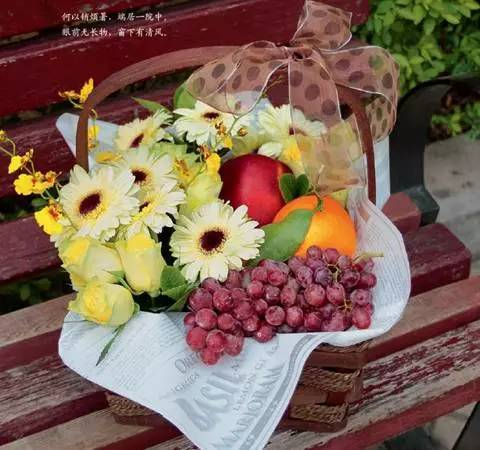
The idea of this wreath is to create a very summery, refreshing and appetizing work, so in addition to choosing some seasonal flowers, a lot of ingredients were also selected.
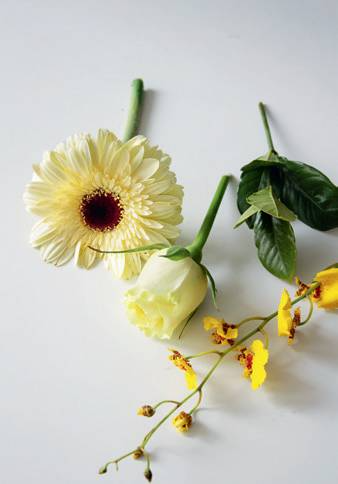
Flowers:
Light yellow gerbera (8 stalks), light yellow rose (9 stalks), oncidium (3 stalks), gardenia leaf (1 stalk)
Alternative flowers:
Gerbera can be replaced by Platycodon grandiflorum
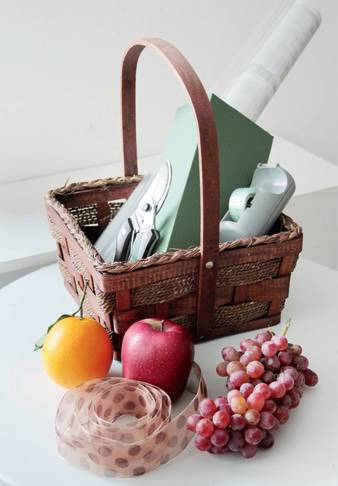
tool:
Square flower basket, flower mud, cellophane, plastic wrapping paper, scissors, transparent tape, ribbon, fruit
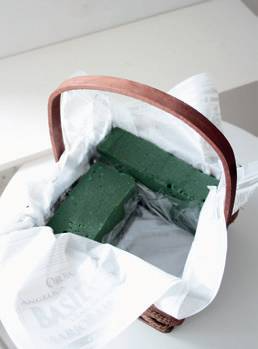
Step 1: Place plastic wrapping paper inside the flower basket, cut the floral paste into appropriate sizes according to the flower basket, and wrap it with cellophane. Place the floral paste in the basket and arrange it in an "L" shape.
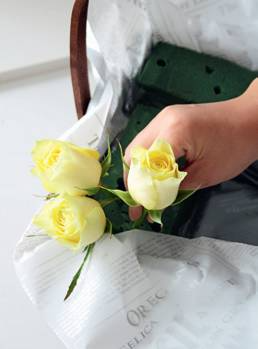
Step 2: Cut 3 roses short to about 5cm, and insert them diagonally into the floral mud in the basket, with the flower heads facing out of the basket and the 3 flowers forming a triangle.
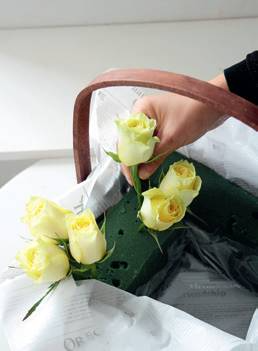
Step 3: Arrange 3 roses into a triangle with the flower heads facing the inside of the basket, and insert them into the corners of the "L"-shaped floral paste.
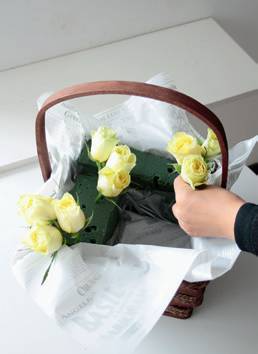
Step 4: Insert the remaining 3 roses into the tail of the "L"-shaped floral paste as shown in the picture, with the flower heads facing the outside of the basket.
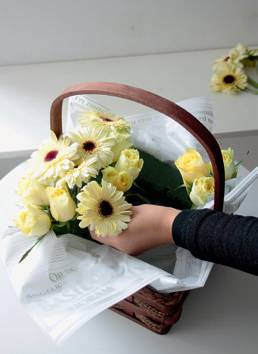
Step 5: Insert the gerberas between the roses. Be careful not to insert them too high. They need to be inserted at different heights. Those close to the inside of the basket should be inserted as low as possible, with the flower heads facing the inside of the basket.
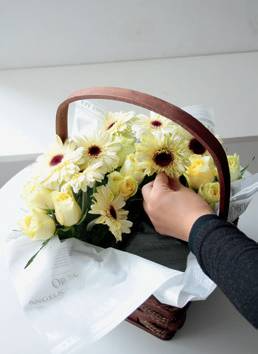
Step 6: Try to spread the gerberas among the roses.
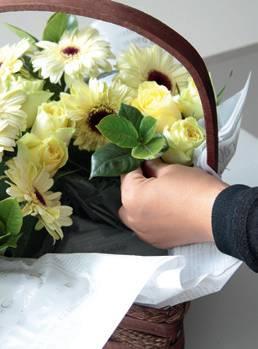
Step 7: Cut the gardenia leaves into short branches and decorate them in places where the floral mud can still be seen.
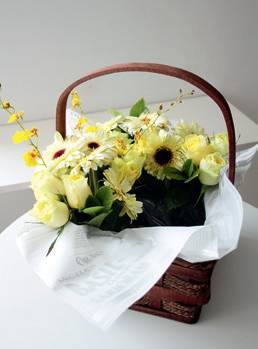
Step 8: Decorate the front of the flower basket with 3 Oncidium orchids, and the flower basket making part is completed.
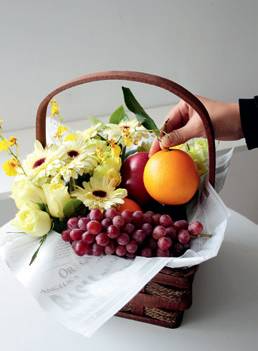
Step 9: Place the prepared fruit into the basket.
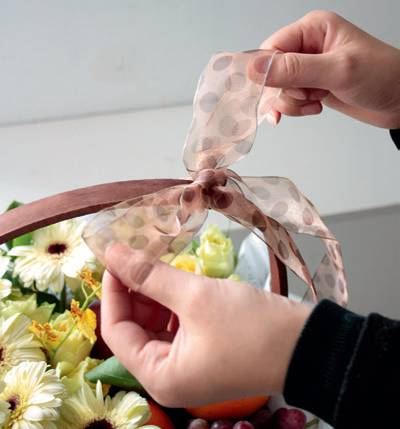
Step 10: Tie a bow with a ribbon on the handle of the basket.
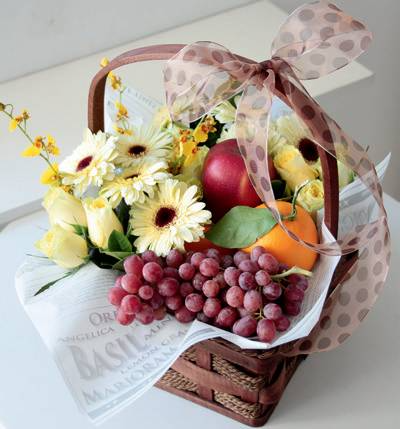
Step 11: Once completed, you can spray the fruit with a little water.